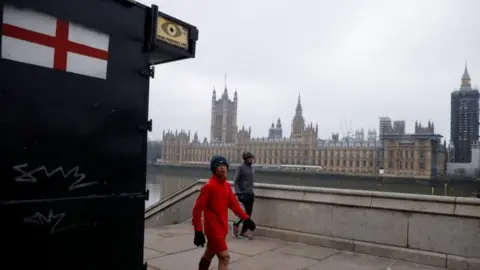Boundary review: England to gain more MPs as Wales loses out
 Reuters
ReutersEngland will receive an additional 10 MPs under a planned review of parliamentary constituency boundaries beginning this month.
The shake-up - based on latest voter registration figures - will see Scotland lose two seats and Wales lose eight.
The political map is being redrawn to ensure constituencies are around the same size.
Detailed proposals are expected in the summer, to be finalised by July 2023.
The task of redesigning constituencies for the first time since 2010 is being carried out by independent commissions in each UK nation.
The total number of seats in the House of Commons will stay at 650 - after plans to cut 50 seats were dropped by the government in March 2020.
Proposals to reduce the number of MPs to 600 had been put forward by former Prime Minister David Cameron in a bid to reduce the cost of politics.
However, the government abandoned the plans last year, citing a "greater workload" for MPs in the wake of the UK's exit from the European Union.
Although the number of seats in England will now rise overall to 543, some regions such as the North West and the North East will see their seats reduced.
The biggest winner from the review will be the South East, which will gain six seats to take its total to 89. South-western England will also gain three more MPs.
The number of seats in Northern Ireland will remain at the current 18. The changes will leave Wales with 32 seats and Scotland with 57.
Party impact
The new allocations have been devised using a formula set out in legislation, based on the latest official statistics on the number of voters in each area published on Tuesday.
Officials in each UK nation will now begin the task of redrawing constituency boundaries to ensure between 68,313 and 77,062 people live in each one.
Martin Baxter, from the polling consultancy Electoral Calculus, said the Conservatives were likely to gain around ten seats from Labour under the planned revisions.
"The change is because Labour's existing seats in Wales and the north of England are a bit smaller than average, so some of them disappear and new seats are created in the south and east of England," he said.
"But the overall change is quite small, and only equivalent to about 1% of voters changing their mind about which party to vote for," he added.
"From the December 2019 election to the following spring, there was a swing of 6% towards the Conservatives, and from then until the end of the year there was a swing of 10% towards Labour.
"So the final composition of the next Parliament will be set much more by the voters' choices than by any boundary changes."
'Fairer elections'
Tim Bowden, secretary to the Boundary Commission for England, said they will bear in mind "local ties" and "geography on the ground".
"Everyone's views will help us recommend a well-considered and practical set of new constituency boundaries in England," he added.
Wales had been expected to lose out under the new proposals, which have previously been criticised by Welsh nationalist party Plaid Cymru.
But the UK government has said the changes reflect "significant changes" in population since the last review and make elections "fairer".
